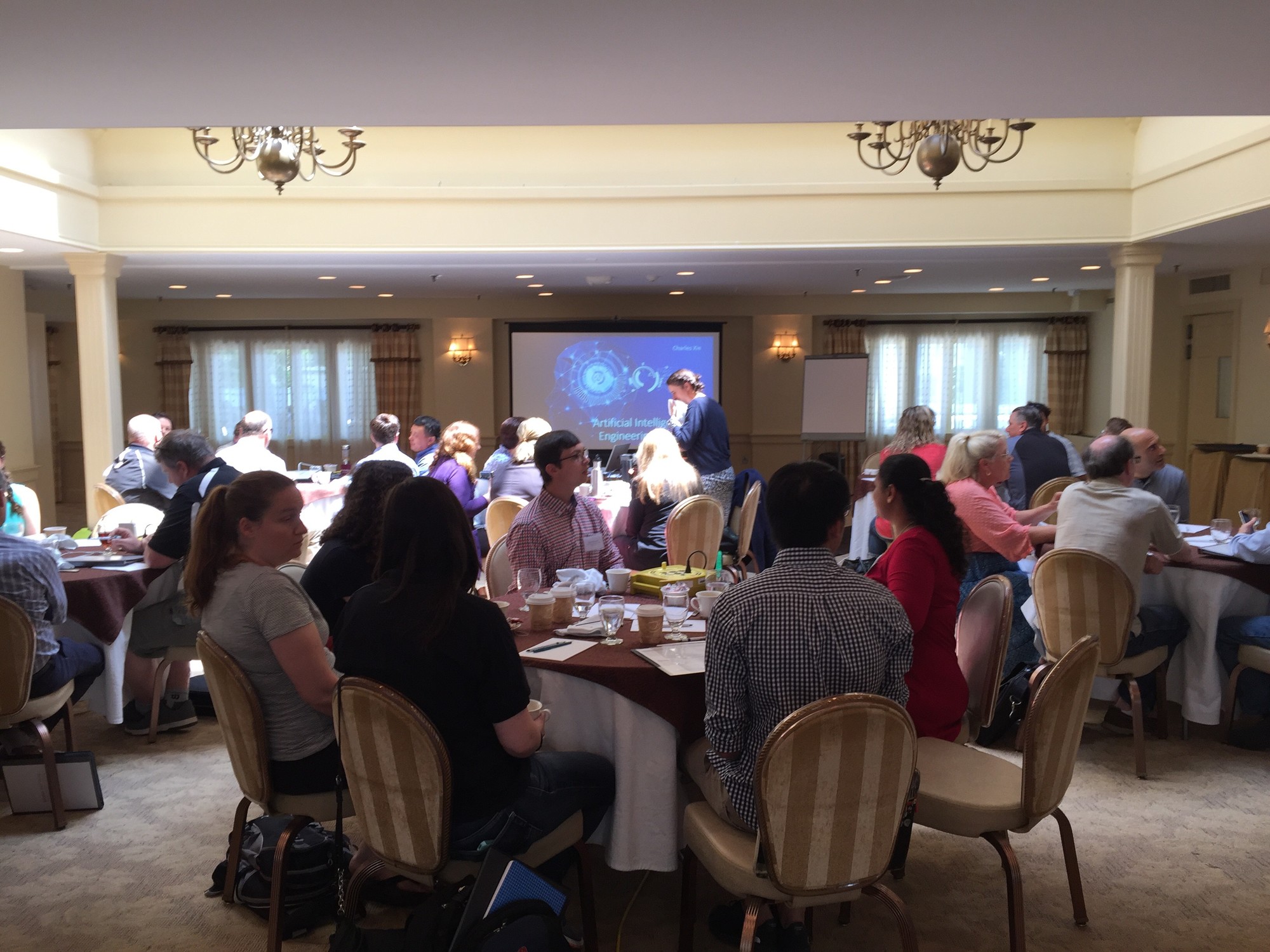In June 10-12, we hosted a successful teacher professional development workshop
in York, Maine for 29 teachers from seven states. The theme was around
the application of artificial intelligence (AI) in engineering
education to assist teaching and foster learning. The workshop was supported by generous funding from General
Motors and the National Science Foundation.
 The teachers explored how the AI tools built in Energy3D could help
students learn STEM concepts and skills required by the Next Generation
Science Standards (NGSS), especially engineering design. Together we brainstormed how AI applications
such as generative design might change their teaching. We believed that
AI could transform STEM education from the following four aspects: (1) augment students with tools that accelerate problem solving, thereby supporting them to explore more broadly; (2) identify cognitive gaps between students' current knowledge and the learning goals, thereby enabling them to learn more deeply; (3) suggest alternative solutions beyond students' current work, thereby spurring them to think more creatively; and (4) assess students' performance by computing the distances between their solutions and the optimal ones, thereby providing formative feedback during the design process. The activities that the teachers tried were situated in the context of building science and
solar engineering, facilitated by our Solarize Your World Curriculum. We presented examples that demonstrated the affordances of AI for supporting
learning and teaching along the above four directions, especially in
engineering design (which is highly open-ended). Teachers first learned how to design a solar farm in
the conventional way and then learned how to accomplish the same task
in the AI way, which -- in theory -- can lead to broader exploration, deeper understanding, better solutions, and faster feedback.
The teachers explored how the AI tools built in Energy3D could help
students learn STEM concepts and skills required by the Next Generation
Science Standards (NGSS), especially engineering design. Together we brainstormed how AI applications
such as generative design might change their teaching. We believed that
AI could transform STEM education from the following four aspects: (1) augment students with tools that accelerate problem solving, thereby supporting them to explore more broadly; (2) identify cognitive gaps between students' current knowledge and the learning goals, thereby enabling them to learn more deeply; (3) suggest alternative solutions beyond students' current work, thereby spurring them to think more creatively; and (4) assess students' performance by computing the distances between their solutions and the optimal ones, thereby providing formative feedback during the design process. The activities that the teachers tried were situated in the context of building science and
solar engineering, facilitated by our Solarize Your World Curriculum. We presented examples that demonstrated the affordances of AI for supporting
learning and teaching along the above four directions, especially in
engineering design (which is highly open-ended). Teachers first learned how to design a solar farm in
the conventional way and then learned how to accomplish the same task
in the AI way, which -- in theory -- can lead to broader exploration, deeper understanding, better solutions, and faster feedback.
View my PowerPoint slides for more information.
 The teachers explored how the AI tools built in Energy3D could help
students learn STEM concepts and skills required by the Next Generation
Science Standards (NGSS), especially engineering design. Together we brainstormed how AI applications
such as generative design might change their teaching. We believed that
AI could transform STEM education from the following four aspects: (1) augment students with tools that accelerate problem solving, thereby supporting them to explore more broadly; (2) identify cognitive gaps between students' current knowledge and the learning goals, thereby enabling them to learn more deeply; (3) suggest alternative solutions beyond students' current work, thereby spurring them to think more creatively; and (4) assess students' performance by computing the distances between their solutions and the optimal ones, thereby providing formative feedback during the design process. The activities that the teachers tried were situated in the context of building science and
solar engineering, facilitated by our Solarize Your World Curriculum. We presented examples that demonstrated the affordances of AI for supporting
learning and teaching along the above four directions, especially in
engineering design (which is highly open-ended). Teachers first learned how to design a solar farm in
the conventional way and then learned how to accomplish the same task
in the AI way, which -- in theory -- can lead to broader exploration, deeper understanding, better solutions, and faster feedback.
The teachers explored how the AI tools built in Energy3D could help
students learn STEM concepts and skills required by the Next Generation
Science Standards (NGSS), especially engineering design. Together we brainstormed how AI applications
such as generative design might change their teaching. We believed that
AI could transform STEM education from the following four aspects: (1) augment students with tools that accelerate problem solving, thereby supporting them to explore more broadly; (2) identify cognitive gaps between students' current knowledge and the learning goals, thereby enabling them to learn more deeply; (3) suggest alternative solutions beyond students' current work, thereby spurring them to think more creatively; and (4) assess students' performance by computing the distances between their solutions and the optimal ones, thereby providing formative feedback during the design process. The activities that the teachers tried were situated in the context of building science and
solar engineering, facilitated by our Solarize Your World Curriculum. We presented examples that demonstrated the affordances of AI for supporting
learning and teaching along the above four directions, especially in
engineering design (which is highly open-ended). Teachers first learned how to design a solar farm in
the conventional way and then learned how to accomplish the same task
in the AI way, which -- in theory -- can lead to broader exploration, deeper understanding, better solutions, and faster feedback.View my PowerPoint slides for more information.








No comments:
Post a Comment